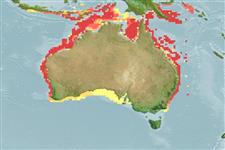Actinopterygii (ray-finned fishes) >
Perciformes (Perch-likes) >
Scombridae (Mackerels, tunas, bonitos) > Scombrinae
Etymology: Cybiosarda: Greek, kybion = tunna + Latin, sarda = sardine (Ref. 45335).
Environment / Climate / Range
Ecology
Marine; pelagic-neritic; oceanodromous (Ref. 51243); depth range 50 - ? m. Tropical, preferred ?; 6°S - 41°S, 108°E - 158°E (Ref. 168)
Western Pacific: restricted to the northern three quarters of Australia (absent from the south coast) and the southern coast of Papua New Guinea.
Size / Weight / Age
Maturity: Lm ? range ? - ? cm
Max length : 45.0 cm FL male/unsexed; (Ref. 168); common length : 35.0 cm FL male/unsexed; (Ref. 168); max. published weight: 2.0 kg (Ref. 168)
Dorsal
spines
(total): 16 - 18;
Dorsal
soft rays
(total): 17-19;
Anal
spines: 0;
Anal
soft rays: 15 - 17;
Vertebrae: 45 - 50. Mouth rather large, upper jaw reaching to hind margin of eye. Laminae of olfactory rosette 28 to 33. Interpelvic process small and bifid. Body mostly naked behind the well developed corselet except for a band of scales along the bases of dorsal and anal fins and patches around the bases of the pectoral and pelvic fins. Swim bladder absent. The back is deep blue, covered with elongate black spots; the belly is light with several stripes like those of the skipjack tuna.
An epipelagic, neritic species that forms schools of several hundred individuals. Taken as bait for snappers by commercial fishers, and for marlins and sharks by sport fishers. Its meat is white and dry and is good when smoked or served steamed with moderately flavored white sauce.
Life cycle and mating behavior
Maturity | Reproduction | Spawning | Eggs | Fecundity | Larvae
Collette, B.B. and C.E. Nauen, 1983. FAO Species Catalogue. Vol. 2. Scombrids of the world. An annotated and illustrated catalogue of tunas, mackerels, bonitos and related species known to date. Rome: FAO. FAO Fish. Synop. 125(2):137 p. (Ref. 168)
IUCN Red List Status (Ref. 115185)
CITES (Ref. 94142)
Not Evaluated
Threat to humans
Harmless
Human uses
Fisheries: minor commercial; gamefish: yes; bait: usually
More information
Common namesSynonymsMetabolismPredatorsEcotoxicologyReproductionMaturitySpawningFecundityEggsEgg development
ReferencesAquacultureAquaculture profileStrainsGeneticsAllele frequenciesHeritabilityDiseasesProcessingMass conversion
Tools
Special reports
Download XML
Internet sources
Estimates of some properties based on models
Phylogenetic diversity index (Ref.
82805): PD
50 = 1.0000 [Uniqueness, from 0.5 = low to 2.0 = high].
Trophic Level (Ref.
69278): 4.0 ±0.7 se; Based on size and trophs of closest relatives
Resilience (Ref.
69278): High, minimum population doubling time less than 15 months (Preliminary K or Fecundity.).
Vulnerability (Ref.
59153): Low to moderate vulnerability (29 of 100) .
